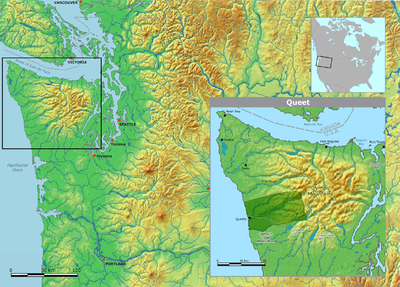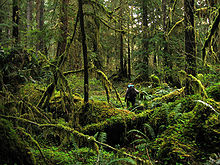Queet
The Queet , formerly also called Quaitso , were an Indian tribe living in what is now Washington State . They lived on the Queets River and its tributaries in the west of the Olympic Peninsula and culturally belonged to the coastal Salish . Their neighbors south of the Queets River were the Quinault , who also belonged to the coastal Salish, and the Quileute in the north, who linguistically do not belong to the Salish but to the Chimakuan .
Like most of the tribes in the northwest, the Queet mainly lived on salmon .
history
Tribal coalitions
Around 1800 the Queet may have escaped to the Quinault area because they wanted to get away from the Chehalis from the south. There was a federation with the Hoh , Quileute and Quinault to ward off attacks by southern groups from Columbia , to which above all the said Chehalis belonged, but also northern groups such as the Klallam , Satsop , Makah and Ozette . According to oral tradition, it controlled the area between the Makah in the northwest and Grays Harbor in the south. Together with the Queet, the Hoh were responsible for the central section of the coast to repel attacks and protect the hunting areas.
First contacts with whites
When the Lewis and Clark expedition reached the west coast, the number of queets was estimated at 250. The extent to which their numbers had already been reduced by the catastrophic smallpox epidemic of 1775 can no longer be determined.
Similar to their neighbors, the Queet traded widely as far as Columbia in the south and Vancouver Island in the north. This is probably one reason why the Queet found out about the conflicts with whites early on and in 1854 forcibly prevented an Indian agent from traveling to their area. Around this time, a Howyatchi (Hoo-e-yas'lsee) or Sampson was the tribal leader for the representatives of the USA.
The treaty with the USA (1855/59) and the merger with the Quinaults
Together with their neighbors, the Queet appeared in 1855 for a meeting with the Governor of Washington Territory Isaac Stevens at the Chehalis Treaty Council in early 1855. A Chehalis shaman - as reported by the settler James Swan - shot a young Queet chief who opposed himself had pronounced the contract. On July 1, 1855, the Quinault River Treaty came about, which was ratified on March 8, 1859. The Quinault Reservation was intended for the Queet , but, like their neighbors, they had understood the treaty not as an exchange of their land for subsidies, but as a gift for keeping the treaty, and the settlers - 1874 if there were only five families - let live with them. So they didn't even think about going to the designated reserve. The government, in turn, let them go as they supported the settlers and lived on good terms with them.
Together with these Quinaults, the Queet achieved an enlargement of the reserve in 1873.
The Indian Shaker Church , which also reached Queet after 1882, campaigned for a peaceful relationship with the settlers. In 1885 only 85 people were considered to be members of the Queet, in 1936 there were 82. The Queet are now part of the Quinault tribe. In 1962, the two tribes received redress of $ 205,172.40 (Docket 242).
literature
- Robert H. Ruby / John A. Brown: A Guide to the Indian Tribes of the Pacific Northwest , University of Oklahoma Press 1992, pp. 170f.


